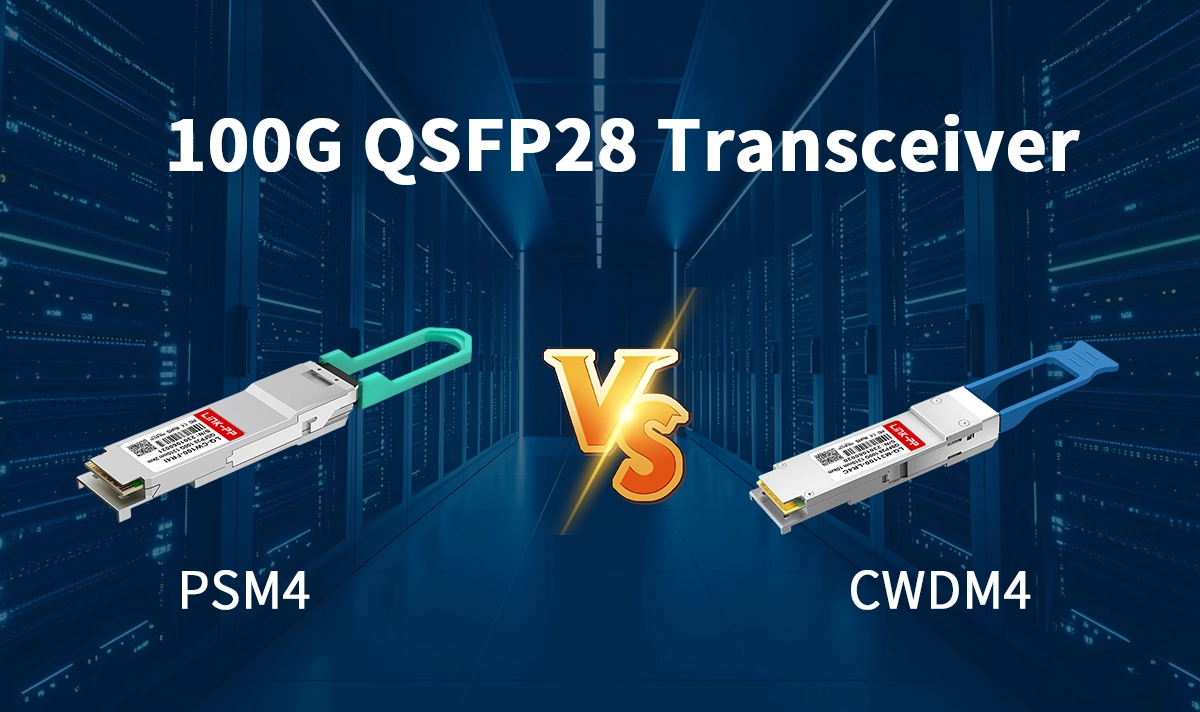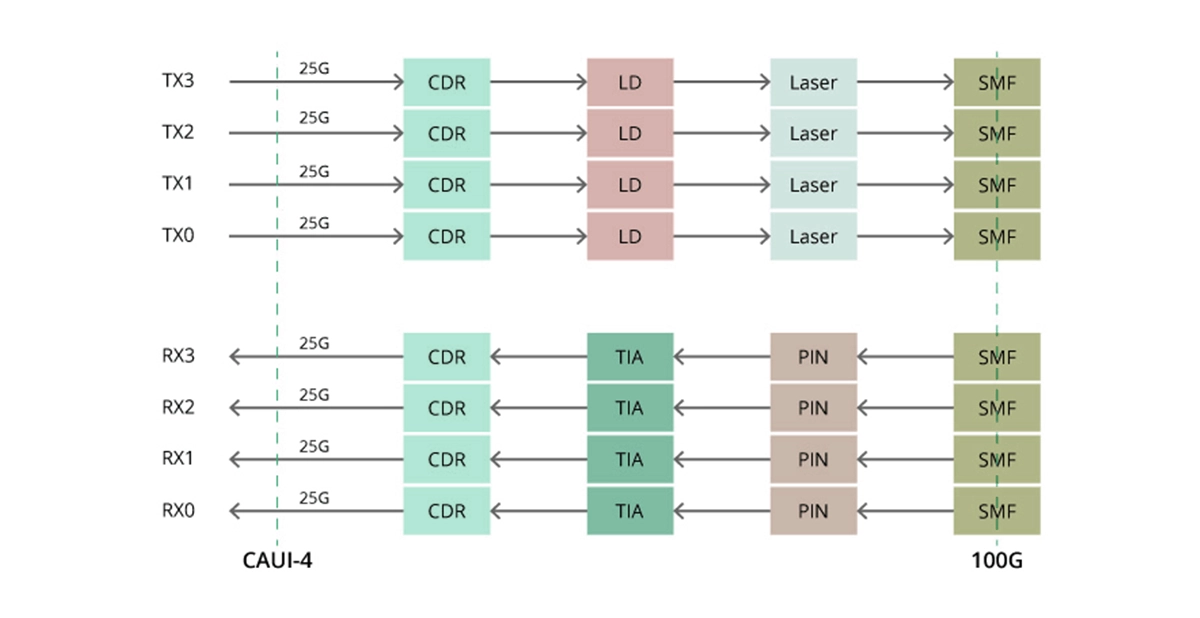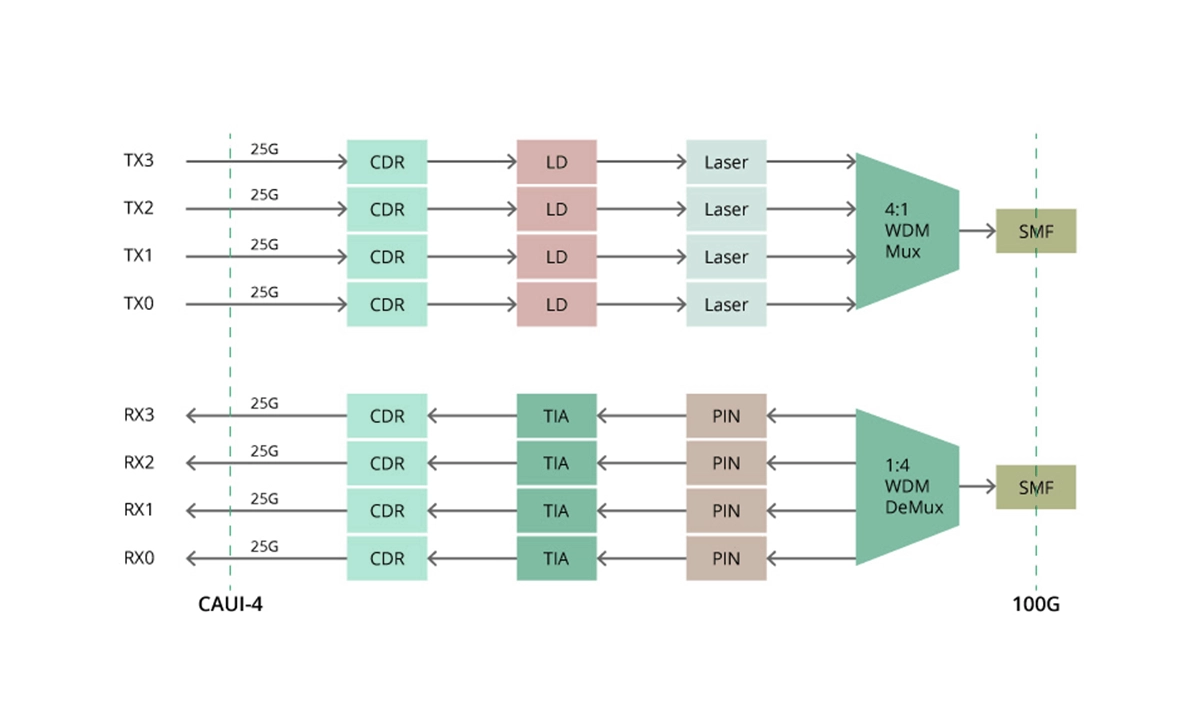
Demand for 100G connectivity in data centers and enterprise networks is exploding. Choosing the right optical transceiver (100G QSFP28) is critical for performance, cost, scalability, and power efficiency. Two dominant MSA (Multi-Source Agreement) standards emerged: PSM4 (Parallel Single Mode fiber 4 lane) and CWDM4 (Coarse Wavelength Division Multiplexing 4 lane). While both achieve 100G over 2km using single-mode fiber (SMF), their underlying technologies and ideal use cases differ significantly. Understanding these 100G transceiver differences is key to optimizing data center networks and reducing optical interconnect costs.
🔧 PSM4: Parallelism Power

PSM4 (IEEE 802.3bm) takes a straightforward parallel approach:
Technology: Uses 4 independent optical lanes (each at 1310nm wavelength).
Fiber: Requires 8 fibers (4 Tx, 4 Rx) – typically in an MPO-12 connector.
Operation: Each lane transmits 25Gbps data simultaneously over its dedicated fiber pair.
Strengths: Simpler optical design potentially leading to lower component costs, excellent signal isolation.
Weaknesses: Higher fiber count consumption, larger cable bulk.
Ideal For: Ultra-short reach (≤ 500m) within racks or rows, high-density direct attach scenarios where fiber count isn't a primary constraint. A reliable PSM4 optical module like the LINK-PP LQ-M31100-DR4C delivers consistent performance for these demanding parallel optics applications.
🌈 CWDM4: Wavelength Wizardry

CWDM4 (MSA Specification) leverages optical multiplexing to conserve fiber:
Technology: Uses 4 different CWDM wavelengths (~1271nm, 1291nm, 1311nm, 1331nm) multiplexed onto a single fiber pair.
Fiber: Requires only 2 fibers (1 Tx, 1 Rx) – typically LC duplex.
Operation: A multiplexer (Mux) combines the 4 wavelengths onto the Tx fiber; a demultiplexer (Demux) separates them on the Rx end.
Strengths: Drastically reduces fiber count (4x less than PSM4), smaller cables, easier cable management, standard LC connectors.
Weaknesses: Requires more complex (and potentially costlier) lasers and Mux/Demux components.
Ideal For: The sweet spot for most 2km 100G links (e.g., intra-data center interconnect, campus links). It's the go-to solution for CWDM4 fiber efficiency and cost-effective 100G connectivity. The LINK-PP LQ-CW100-FR4C is engineered for maximum reliability in these wavelength multiplexed networks.
🥊 Head-to-Head: PSM4 vs. CWDM4 - The Key Differences
Feature | PSM4 (100G-PSM4) | CWDM4 (100G-CWDM4) | Winner for... |
|---|---|---|---|
Technology | 4x Parallel 1310nm Lanes | 4x WDM (1271/1291/1311/1331nm) | Simplicity (PSM4) / Fiber Eff. (CWDM4) |
Fiber Count | 8 Fibers (MPO-12) | 2 Fibers (LC Duplex) | CWDM4 (Significant Savings) |
Reach | Up to 500m (Optimal), 2km | Up to 2km (Standard) | Tie (Both do 2km, PSM4 better ≤500m) |
Connector | MPO-12/APC | LC Duplex | CWDM4 (Standard, Easier Mgmt) |
Laser Complexity | Simpler (4x same λ) | More Complex (4x Diff λ, Mux/Demux) | PSM4 (Potentially Lower Cost) |
Cable Bulk | Higher (Thicker cable) | Lower (Thinner cable) | CWDM4 |
Primary Use Case | Short Reach, High Density | Standard 2km ICI, DCI | Depends on Distance/Fiber Needs |
Cost Factor (Components) | Potentially Lower Laser | Potentially Higher Laser + Mux/Demux | Context Dependent |
Cost Factor (Infra) | Higher (More Fiber/Cabling) | Lower (Less Fiber/Cabling) | CWDM4 (Overall Infra Cost) |
🏆 Choosing Your Champion: PSM4 or CWDM4?
Choose PSM4 If:
Your links are very short (≤ 500m).
Fiber infrastructure is abundant and cheap, and cable bulk isn't a major issue.
You prioritize potential component cost savings over fiber efficiency for specific short-reach deployments.
You need high-density parallel optics within a confined space.
Choose CWDM4 If (The Most Common Choice):
Your links are up to 2km.
Fiber conservation is critical (saves significant cost and complexity).
Easier cable management with LC duplex is preferred.
You need a standard, widely interoperable solution for data center interconnects (DCI) or enterprise backbone links.
Overall infrastructure cost (fiber + cabling + management) is a key driver.
💡 LINK-PP Solutions: Engineered for Performance & Value
Whether your 100G network design calls for the parallel efficiency of PSM4 or the wavelength-multiplexing prowess of CWDM4, LINK-PP delivers high-performance, MSA-compliant solutions:
For Demanding Short-Reach Parallelism: The LINK-PP PSM4 transceivers offers robust performance for cost-sensitive 100G optics in dense, short-distance applications.
For Efficient 2km Interconnect: LINK-PP provides reliable, low-power consumption 100G CWDM4 transceivers optimized for scalable data center solutions and high-bandwidth enterprise networks.
Both modules undergo rigorous optical transceiver testing to ensure compatibility, low bit error rate (BER), and longevity, giving you confidence in your optical network infrastructure.
✅ Conclusion: Optimizing Your Optical Edge
Understanding the differences between PSM4 and CWDM4 is fundamental for making informed 100G transceiver selection. While PSM4 offers simplicity for ultra-short parallel runs, CWDM4 has become the dominant standard for 2km 100G links due to its superior fiber efficiency, easier management, and lower overall infrastructure costs.
Ready to optimize your 100G deployment with the right optical solution? 🔗
👉 Explore LINK-PP's full range of high-performance, reliable 100G QSFP28 modules, including our industry-leading CWDM4 transceivers and PSM4 transceivers, designed to deliver maximum value and uptime for your critical links.
📝 FAQ
What is the main difference between PSM4 and CWDM4?
PSM4 needs eight fibers and uses MPO/MTP connectors. It sends data in parallel. CWDM4 only needs two fibers and uses LC duplex connectors. It sends data using different wavelengths.
PSM4 is good for short links. CWDM4 is better for longer distances.
Which transceiver is easier to install in existing networks?
CWDM4 is usually easier to put in. Most networks already use LC connectors and two-fiber cables.
PSM4 might need new parallel fiber if you do not have it.
Which option is more cost-effective for short distances?
PSM4 often costs less for short links if you already have parallel fiber.
CWDM4 can save money on cables for new or bigger networks.
Can both PSM4 and CWDM4 support future network upgrades?
CWDM4 is better for upgrades. It uses fewer fibers, so adding more is easy.
PSM4 might need more space as your network gets bigger.
Which transceiver should a data center choose for long links?
A data center should pick CWDM4 for links up to 2 kilometers.
PSM4 is best for short links inside a building.




